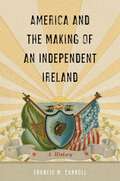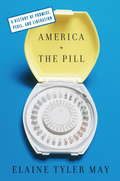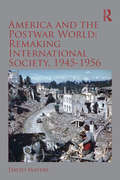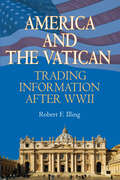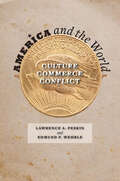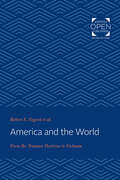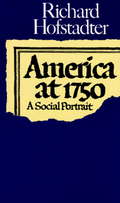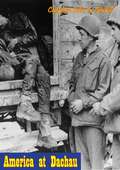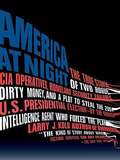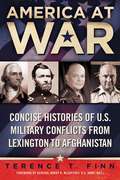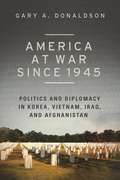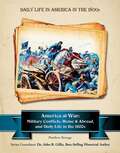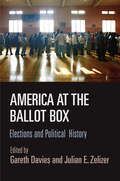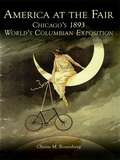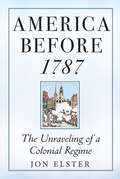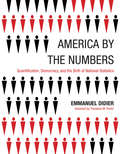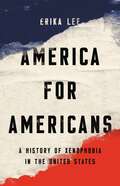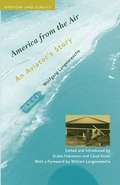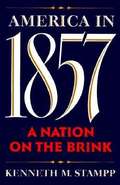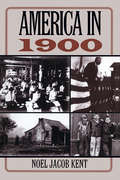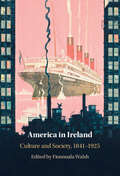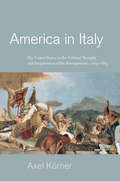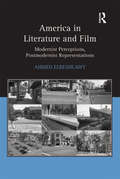- Table View
- List View
America and the Making of an Independent Ireland: A History (The Glucksman Irish Diaspora Series #1)
by Francis M. CarrollExamines how the Irish American community, the American public, and the American government played a crucial role in the making of a sovereign independent IrelandOn Easter Day 1916, more than a thousand Irishmen stormed Dublin city center, seizing the General Post Office building and reading the Proclamation for an independent Irish Republic. The British declared martial law shortly afterward, and the rebellion was violently quashed by the military. In a ten-day period after the event, fourteen leaders of the uprising were executed by firing squad.In New York, news of the uprising spread quickly among the substantial Irish American population. Initially the media blamed German interference, but eventually news of British-propagated atrocities came to light, and Irish Americans were quick to respond.America and the Making of an Independent Ireland centres on the diplomatic relationship between Ireland and the United States at the time of Irish Independence and World War I. Beginning with the Rising of 1916, Francis M. Carroll chronicles how Irish Americans responded to the movement for Irish independence and pressuring the US government to intervene on the side of Ireland. Carroll’s in-depth analysis demonstrates that Irish Americans after World War I raised funds for the Dáil Éireann government and for war relief, while shaping public opinion in favor of an independent nation. The book illustrates how the US government was the first power to extend diplomatic recognition to Ireland and welcome it into the international community.Overall, Carroll argues that the existence of the state of Ireland is owed to considerable effort and intervention by Irish Americans and the American public at large.
America and the Pill: A History of Promise, Peril, and Liberation
by Elaine Tyler MayIn 1960, the FDA approved the contraceptive commonly known as "the pill. ” Advocates, developers, and manufacturers believed that the convenient new drug would put an end to unwanted pregnancy, ensure happy marriages, and even eradicate poverty. But as renowned historian Elaine Tyler May reveals in America and the Pill, it was women who embraced it and created change. They used the pill to challenge the authority of doctors, pharmaceutical companies, and lawmakers. They demonstrated that the pill was about much more than family planning-it offered women control over their bodies and their lives. From little-known accounts of the early years to personal testimonies from young women today, May illuminates what the pill did and did not achieve during its half century on the market.
America and the Postwar World: Remaking International Society, 1945-1956 (Routledge Studies in Modern History)
by David MayersThe main tide of international relations scholarship on the first years after World War II sweeps toward Cold War accounts. These have emphasized the United States and USSR in a context of geopolitical rivalry, with concomitant attention upon the bristling security state. Historians have also extensively analyzed the creation of an economic order (Bretton Woods), mainly designed by Americans and tailored to their interests, but resisted by peoples residing outside of North America, Western Europe, and Japan. This scholarship, centered on the Cold War as vortex and a reconfigured world economy, is rife with contending schools of interpretation and, bolstered by troves of declassified archival documents, will support investigations and writing into the future. By contrast, this book examines a past that ran concurrent with the Cold War and interacted with it, but which usefully can also be read as separable: Washington in the first years after World War II, and in response to that conflagration, sought to redesign international society. That society was then, and remains, an admittedly amorphous thing. Yet it has always had a tangible aspect, drawing self-regarding states into occasional cooperation, mediated by treaties, laws, norms, diplomatic customs, and transnational institutions. The U.S.-led attempt during the first postwar years to salvage international society focused on the United Nations Relief and Rehabilitation Administration, the Acheson–Lilienthal plan to contain the atomic arms race, the Nuremberg and Tokyo tribunals to force Axis leaders to account, the 1948 Genocide Convention, the 1948 Universal Declaration of Human Rights, and the founding of the United Nations. None of these initiatives was transformative, not individually or collectively. Yet they had an ameliorative effect, traces of which have touched the twenty-first century—in struggles to curb the proliferation of nuclear weapons, bring war criminals to justice, create laws supportive of human rights, and maintain an aspirational United Nations, still striving to retain meaningfulness amid world hazards. Together these partially realized innovations and frameworks constitute, if nothing else, a point of moral reference, much needed as the border between war and peace has become blurred and the consequences of a return to unrestraint must be harrowing.
America and the Vatican: Trading Information after World War II
by Robert F. IllingThe reader is given a rare view of the operations of the Vatican in the diplomatic world and some fascinating sidelights into the Vatican archives such as the role Benjamin Franklin played in the selection of the first Catholic Bishop in the United States and what the Pope actually intended to do about Henry the VIII. Robert Illing brings the reader into the fascinating and colorful political world of the Vatican, a unique entity with the dual nature of political state which functions apart from its other position as center of the Roman Catholic Church. A separate politcal state with diplomatic offices in most countries in the world, the Vatican has a unique position as a listening post unlike any other country in the world. Robert Illing brings the reader into that fascinating world.
America and the Vietnam War: Re-examining the Culture and History of a Generation
by Andrew Wiest Mary Kathryn Barbier Glenn RobinsThe Vietnam War was one of the most heavily documented conflicts of the twentieth century. Although the events themselves recede further into history every year, the political and cultural changes the war brought about continue to resonate, even as a new generation of Americans grapples with its own divisive conflict. America and the Vietnam War: Re-examining the Culture and History of a Generation reconsiders the social and cultural aspects of the conflict that helped to fundamentally change the nation. With chapters written by subject area specialists, America and the Vietnam War takes on subjects such as women’s role in the war, the music and the films of the time, the Vietnamese perspective, race and the war, and veterans and post-traumatic stress disorder. Features include: chapter summaries timelines discussion questions guides to further reading a companion website with primary source documents and tools (such as music and movie playlists) for both instructors and students. Heavily illustrated and welcoming to students and scholars of this infamous and pivotal time, America and the Vietnam War is a perfect companion to any course on the Vietnam War Era.
America and the World: Culture, Commerce, Conflict
by Lawrence A. Peskin Edmund F WehrleThis American history explores the country’s role as a globalizing force from the arrival of Columbus to the 21st century.The twenty-first century may be the age of globalization, but America has been at the cutting edge of globalization since Columbus landed here five centuries ago. In America and the World, Lawrence A. Peskin and Edmund F. Wehrle explore America's evolving connections with Europe, Africa, and Asia in the three areas that historically have been indicators of global interaction: trade and industry, diplomacy and war, and the "soft" power of ideas and culture. Divided into four historical phases of globalization, this book considers how international events and trends influenced American as well as how America exerted its own influence—whether economic, cultural, or military—on the world. The authors demonstrate how technology and disease enabled Europeans to subjugate the New World, how colonial American products transformed Europe and Africa, and how post-revolutionary American ideas helped foment revolutions in Europe and elsewhere. Peskin and Wehrle also explore America’s rise to global superpower, and how this power alienated people around the world and bred dissent at home. During the civil rights movement, America borrowed much from the world as it addressed the social issues of the day. At the same time, Americans—especially African Americans—offered a global model for change as the country grappled with racial and gender inequality.
America and the World: Culture, Commerce, Conflict
by Edmund F. Wehrle Lawrence A. PeskinAlthough the twenty-first century may well be the age of globalization, this book demonstrates that America has actually been at the cutting edge of globalization since Columbus landed here five centuries ago.Lawrence A. Peskin and Edmund F. Wehrle explore America's evolving connections with Europe, Africa, and Asia in the three areas that historically have been indicators of global interaction: trade and industry, diplomacy and war, and the "soft" power of ideas and culture. Framed in four chronological eras that mark phases in the long history of globalization, this book considers the impact of international events and trends on the American story as well as the influence America has exerted on world developments. Peskin and Wehrle discuss how the nature of this influence—whether economic, cultural, or military—fluctuated in each period. They demonstrate how technology and disease enabled Europeans to subjugate the New World, how colonial American products transformed Europe and Africa, and how post-revolutionary American ideas helped foment revolutions in Europe and elsewhere. Next, the authors explore the American rise to global economic and military superpower—and how the accumulated might of the United States alienated many people around the world and bred dissent at home. During the civil rights movement, America borrowed much from the world as it sought to address the crippling "social questions" of the day at the same time that Americans—especially African Americans—offered a global model for change as the country strove to address social, racial, and gender inequality. Lively and accessible, America and the World draws on the most recent scholarship to provide a historical introduction to one of today's vital and misunderstood issues.
America and the World: From the Truman Doctrine to Vietnam
by Robert E. OsgoodOriginally published in 1970. This volume presents a study of American foreign policy during the Cold War period, investigating the United States' involvement with the U.S.S.R., China, and communist parties throughout the world.
America at 1750
by Richard HofstadterDemonstrates how the colonies developed into the first nation created under the influences of nationalism, modern capitalism and Protestantism.From the Paperback edition.
America at Dachau
by Chaplain John G. GaskillHarrowing account of U.S. Army chaplain John G. Gaskill of what he witnessed in Dachau.For three months, Gaskill ministered to liberated inmates and imprisoned SS soldiers at Dachau. Every evening for a month, Gaskill and other clergymen held mass funerals for those who died from starvation and disease. Gaskill tore down and kept the German sign forbidding entry to a mass grave on a hill. He replaced it with a cross and a Jewish star. He eventually made German prisoners bury the dead in separate graves in the cemeteries in town."At incredible Dachau, Chaplain Gaskill arranged for all the multitudinous services of the Ministry and Priesthood to be performed as necessary for many denominations in many different tongues. Although much has already been written about Dachau, this article, giving the experiences and observations of Chaplain Gaskill, paints an exceptionally vivid picture and presents it in a different light.--AUBREY L. BRADFORD Colonel MC Commanding."
America at Night
by Larry J. KolbA shocking true account only one man can tell, "the kind. . . about which fiction writers can only dream. "--New York Times When the Department of Homeland Security suspects that two former CIA operatives are at the center of plot involving money laundering and the funding of Al Qaeda-and when their supposedly comprehensive database turns up little to no information on either man-it takes onetime spy Larry Kolb to crack the case. But when Kolb begins to connect the dots, he realizes something even more sinister is afoot, and that he's on to the biggest possible con with the highest political stakes. America at Nightreads like a thriller, but the story is true and extensively documented. Kolb shows us how one well-informed individual did what all of our security agencies could not: trail two brilliant covert political operatives through a labyrinth of disguised identities and dark crimes to expose corruption at the highest levels.
America at War
by Terence T. FinnWar--organized violence against an enemy of the state--seems part and parcel of the American journey. Indeed, the United States was established by means of violence as ordinary citizens from New Hampshire to Georgia answered George Washington's call to arms. Since then, war has become a staple of American history. Counting the War for Independence, the United States has fought the armed forces of other nations at least twelve times, averaging a major conflict every twenty years. In so doing, the objectives have been simple: advance the cause of freedom, protect U.S. interests, and impose America's will upon a troubled world. More often than not, the results have been successful as America's military has accounted itself well. Yet the cost has been high, in both blood and treasure. Americans have fought and died around the globe--on land, at sea, and in the air. Without doubt, their actions have shaped the world in which we live. In this comprehensive collection, Terence T. Finn provides a set of narratives--each concise and readable--on the twelve major wars America has fought. He explains what happened, and why such places as Saratoga and Antietam, Manila Bay and Midway are important to an understanding of America's past. Readers will easily be able to brush up on their history and acquaint themselves with those individuals and events that have helped define the United States of America.
America at War since 1945: Politics and Diplomacy in Korea, Vietnam, Iraq, and Afghanistan
by Gary A. DonaldsonFocusing primarily on politics and foreign policy, America at War since 1945 analyzes America's involvement in its several wars since the end of World War II. The main questions asked are: How did the U.S. become involved in these wars? How were the wars conducted? And how did the U.S. get out of these wars?In Korea and Vietnam, the US fought to show the world that it would stand up to the evils of communism-that it could be counted on (with money, advisors, or even a major military effort if necessary) to halt the advance of communism. But in both wars, the US showed itself to be militarily vulnerable. In its wars against radical Islam since 9/11, the United States has made use of its military to protect its interests in the Middle East, particularly its oil interests, while trying to spread its ideas of democracy, constitutionalism, and the rule of law. The lessons are clear: America's values often do not translate into the less-developed world.In 2016, as the debate over ISIS intensifies, America at War since 1945 reminds us that the history of US postwar military conflict has seldom been marked by clearly defined goals and outcomes. Skyhorse Publishing, as well as our Arcade imprint, are proud to publish a broad range of books for readers interested in history--books about World War II, the Third Reich, Hitler and his henchmen, the JFK assassination, conspiracies, the American Civil War, the American Revolution, gladiators, Vikings, ancient Rome, medieval times, the old West, and much more. While not every title we publish becomes a New York Times bestseller or a national bestseller, we are committed to books on subjects that are sometimes overlooked and to authors whose work might not otherwise find a home.
America at War: Military Conflicts, Home and Abroad, and Daily Life in the 1800 (Daily Life in America in the 1800s)
by Matthew StrangeFrom an isolated and inward-looking new nation clinging to the East Coast, America in the 1800s grew in size, strength, and military might. From the War of 1812 to the century-long campaigns of conquest against Native American peoples, territorial expansion through war with Mexico to the great national tragedy that was the Civil War, American soldiers and sailors forged a tradition of pride and heroism that is part of our national heritage. Sometimes misguided, sometimes truly inspired, nineteenth-century America produced some of the greatest military leaders and witnessed some of the bloodiest battles in our history. Behind the scenes, and often neglected in our official histories, the life of America's citizen soldiers was a tough and brutal one. Patriotism, heroism, and human folly all combine in the story of the roots of America's rise to the status of world military power.
America at the Ballot Box
by Julian E. Zelizer Gareth DaviesElections are, and always have been, the lifeblood of American democracy. Often raucous and sharply contentious, sometimes featuring grand debates about the nation's future, and invariably full of dramatic moments, elections offer insight into the character and historical evolution of American politics. America at the Ballot Box uses the history of presidential elections to illuminate American political democracy and its development from the early Republic to the late twentieth century.Some of the contributions in America at the Ballot Box focus on elections that resulted in dramatic political change, including Jefferson's defeat of Adams in 1800, the 1860 election of Lincoln, and Reagan's 1980 landslide victory. Others concentrate on contests whose importance lies more in the way they illuminate the broad, underlying processes of political change, such as the corruption controversy of Cleveland's acrimonious election in 1884 or the advent of television advertising during the 1952 campaign, when Eisenhower defeated Stevenson. Another set of essays takes a thematic approach, exploring the impact of foreign relations, Anglophobia, and political communications over long periods of electoral time. Uniting all of the chapters is the common conviction that elections provide a unique vantage point from which to view the American political system.Ranging from landmark contests to less influential victories and defeats, the essays by leading political historians seek to rehabilitate the historical significance of presidential elections and integrate them into the broader evolution of American government, policies, and politics.Contributors: Brian Balogh, Gareth Davies, Meg Jacobs, Richard R. John, Kevin M. Kruse, Jeffrey L. Pasley, Andrew Preston, Elizabeth Sanders, Bruce J. Schulman, Jay Sexton, Adam I. P. Smith, Sean Wilentz, Julian E. Zelizer
America at the Fair: Chicago's 1893 World's Columbian Exposition
by Chaim M. RosenbergAt the time of the World's Columbian Exposition of 1893, the United States was fast becoming the world's leading economy. Chicago, the host city, had grown in less than half a century from a village to the country's second-largest metropolis. During this, the Gilded Age, the world's most extensive railroad and steamship networks poured ceaselessly through Chicago, carrying the raw goods and finished products of America's great age of invention and industrial expansion. The Fair was the largest ever at the time, with 65,000 exhibitors and millions of visitors. It has been called the "Blueprint of the American Future" and marked the beginning of the national economy and consumer culture.
America before 1787: The Unraveling of a Colonial Regime
by Jon ElsterAn original account, drawing on both history and social science, of the causes and consequences of the American RevolutionWith America before 1787, Jon Elster offers the second volume of a projected trilogy that examines the emergence of constitutional politics in France and America. Here, he explores the increasingly uneasy relations between Britain and its American colonies and the social movements through which the thirteen colonies overcame their seemingly deep internal antagonisms.Elster documents the importance of the radical uncertainty about their opponents that characterized both British and American elites and reveals the often neglected force of enthusiasm, and of emotions more generally, in shaping beliefs and in motivating actions. He provides the first detailed examinations of &“divide and rule&” as a strategy used on both sides of the Atlantic and of the rise and fall of collective action movements among the Americans. Elster also explains how the gradual undermining in America of the British imperial system took its toll on transatlantic relations and describes how state governments and the American Confederation made crucial institutional decisions that informed and constrained the making of the Constitution.Drawing on a wide range of historical sources and on theories of modern social science, Elster brings together two fields of scholarship in innovative and original ways. The result is a unique synthesis that yields new insights into some of the most important events in modern history.
America by the Numbers: Quantification, Democracy, and the Birth of National Statistics (Infrastructures)
by Emmanuel DidierHow new techniques of quantification shaped the New Deal and American democracy.When the Great Depression struck, the US government lacked tools to assess the situation; there was no reliable way to gauge the unemployment rate, the number of unemployed, or how many families had abandoned their farms to become migrants. In America by the Numbers, Emmanuel Didier examines the development in the 1930s of one such tool: representative sampling. Didier describes and analyzes the work of New Deal agricultural economists and statisticians who traveled from farm to farm, in search of information that would be useful for planning by farmers and government agencies. Didier shows that their methods were not just simple enumeration; these new techniques of quantification shaped the New Deal and American democracy even as the New Deal shaped the evolution of statistical surveys.Didier explains how statisticians had to become detectives and anthropologists, searching for elements that would help them portray America as a whole. Representative surveys were one of the most effective instruments for their task. He examines pre-Depression survey techniques; the invention of the random sampling method and the development of the Master Sample; and the application of random sampling by employment experts to develop the “Trial Census of Unemployment.”
America for Americans: A History of Xenophobia in the United States
by Erika LeeAn award-winning historian reframes our continuing debate over immigration with a compelling history of xenophobia in the United States and its devastating impactThe United States is known as a nation of immigrants. But it is also a nation of xenophobia. In America for Americans, Erika Lee shows that an irrational fear, hatred, and hostility toward immigrants has been a defining feature of our nation from the colonial era to the Trump era. Benjamin Franklin ridiculed Germans for their "strange and foreign ways." Americans' anxiety over Irish Catholics turned xenophobia into a national political movement. Chinese immigrants were excluded, Japanese incarcerated, and Mexicans deported. Today, Americans fear Muslims, Latinos, and the so-called browning of America. Forcing us to confront this history, America for Americans explains how xenophobia works, why it has endured, and how it threatens America. It is a necessary corrective and spur to action for any concerned citizen.
America from the Air: An Aviator's Story
by Wolfgang LangewiescheA memoir of a pilot who learned to fly in the 1930's as well as a look at America from the air as it appeared in the 1940's. At the same time it is a study of the joys of flying.
America in 1857: A Nation on the Brink
by Kenneth StamppIt was a year packed with unsettling events. The Panic of 1857 closed every bank in New York City, ruined thousands of businesses, and caused widespread unemployment among industrial workers. The Mormons in Utah Territory threatened rebellion when federal troops approached with a non-Mormon governor to replace Brigham Young. The Supreme Court outraged northern Republicans and abolitionists with the Dred Scott decision ("a breathtaking example of judicial activism"). And when a proslavery minority in Kansas Territory tried to foist a proslavery constitution on a large antislavery majority, President Buchanan reneged on a crucial commitment and supported the minority, a disastrous miscalculation which ultimately split the Democratic party in two. In America in 1857 , eminent American historian Kenneth Stampp offers a sweeping narrative of this eventful year, covering all the major crises while providing readers with a vivid portrait of America at mid-century. Stampp gives us a fascinating account of the attempt by William Walker and his band of filibusters to conquer Nicaragua and make it a slave state, of crime and corruption, and of street riots by urban gangs such as New York's Dead Rabbits and Bowery Boys and Baltimore's Plug Uglies and Blood Tubs. But the focus continually returns to Kansas. He examines the outrageous political frauds perpetrated by proslavery Kansans, Buchanan's calamitous response and Stephen Douglas's break with the President (a rare event in American politics, a major party leader repudiating the president he helped elect), and the whirl of congressional votes and dramatic debates that led to a settlement humiliating to Buchanan--and devastating to the Democrats. 1857 marked a turning point, at which sectional conflict spun out of control and the country moved rapidly toward the final violent resolution in the Civil War. Stampp's intensely focused look at this pivotal year illuminates the forces at work and the mood of the nation as it plummeted toward disaster.
America in 1900
by Noel J KentMany of the key issues concerning the United States as we enter the 21st century were already taking shape as we entered the 20th century. Business mergers, U.S. military intervention (in the Philippines), trade disputes with China and Europe, racial violence, high levels of crime, rising income gaps between rich and poor, volatile stock market prices, homelessness in the cities, the dangers of immigration, and the domination of money in elections -- all these major national issues in 1900 are familiar in some form to Americans today. The nation grappled for the first time with a series of complex new challenges: distribution of wealth and economic opportunity; the form race and ethnic relations should take in a country of increasing diversity; the relationship between big business and government; how the United States, as a new world power, should act overseas; and a host of others. Written in a fluid and highly readable style, Kent's ten chapters comprise a colorful narrative history of the major events of this pivotal year that continues to resonate a century later.
America in Ireland: Culture and Society, 1841–1925
by Fionnuala WalshWhile the impacts of Irish emigration to America following the Great Famine of 1845–1852 have been well studied, comparatively little scholarly attention has been paid to the effects of reverse migration on Irish culture, society, and politics. Inspired by the work of historian David P. B. Fitzpatrick (1948–2019) and forming a companion to his final published work The Americanisation of Ireland: Migration and Settlement 1841–1925 (Cambridge, 2019), this volume explores the influence of America in shaping Ireland's modernisation and globalisation. The essays use the concept of Americanisation to explore interdisciplinary themes of material culture, marketing, religion, politics, literature, cinema, music, and folklore. America in Ireland reveals a late nineteenth and early twentieth-century Irish society that was more cosmopolitan than previously assumed, in which 'Returned Yanks' brought home new-fangled notions of behaviour and activities and introduced their families to American products, culture and speech. In doing so, this book demonstrates the value of a transnational and global perspective for understanding Ireland's history.
America in Italy: The United States in the Political Thought and Imagination of the Risorgimento, 1763-1865
by Axel KörnerAmerica in Italy examines the influence of the American political experience on the imagination of Italian political thinkers between the late eighteenth century and the unification of Italy in the 1860s. Axel Körner shows how Italian political thought was shaped by debates about the American Revolution and the U.S. Constitution, but he focuses on the important distinction that while European interest in developments across the Atlantic was keen, this attention was not blind admiration. Rather, America became a sounding board for the critical assessment of societal changes at home.Many Italians did not think the United States had lessons to teach them and often concluded that life across the Atlantic was not just different but in many respects also objectionable. In America, utopia and dystopia seemed to live side by side, and Italian references to the United States were frequently in support of progressive or reactionary causes. Political thinkers including Cesare Balbo, Carlo Cattaneo, Giuseppe Mazzini, and Antonio Rosmini used the United States to shed light on the course of their nation's political resurgence. Concepts from Montesquieu, Rousseau, and Vico served to evaluate what Italians discovered about America. Ideas about American "domestic manners" were reflected and conveyed through works of ballet, literature, opera, and satire.Transcending boundaries between intellectual and cultural history, America in Italy is the first book-length examination of the influence of America's political formation on modern Italian political thought.
America in Literature and Film: Modernist Perceptions, Postmodernist Representations
by Ahmed ElbeshlawyUtilizing Lacan's psychoanalytic theory and Zizek's philosophical adaption of it, this book brings into dialogue a series of modernist and postmodernist literary works, films, and critical theory that are concerned with defining America. Ahmed Elbeshlawy demonstrates that how America is perceived in certain texts reveals not only the idealization or condemnation of it, but an imago, or constructed image of the perceiver as well. In turn, texts which particularly focus on demonstrating how other texts about America communicate an untrustworthy message themselves communicate an unreliable message, inventing and reinventing a series of imagos of America. These imagos refer to both idealized and deformed images of America constructed by the perceivers of America. The first part of this book is concerned with modernist perceptions of America, and includes discussion of Adorno, Benjamin, Kafka, D. H. Lawrence, as well as Emerson and Seymour Martin Lipset. The second part is dedicated to postmodernist representations of America, focusing on texts by Edward Said, Ihab Hassan, Susan Sontag, David Shambaugh and Charles W. Brooks, and films including Lars von Trier's Dogville and D.W. Griffith's Birth of a Nation.
